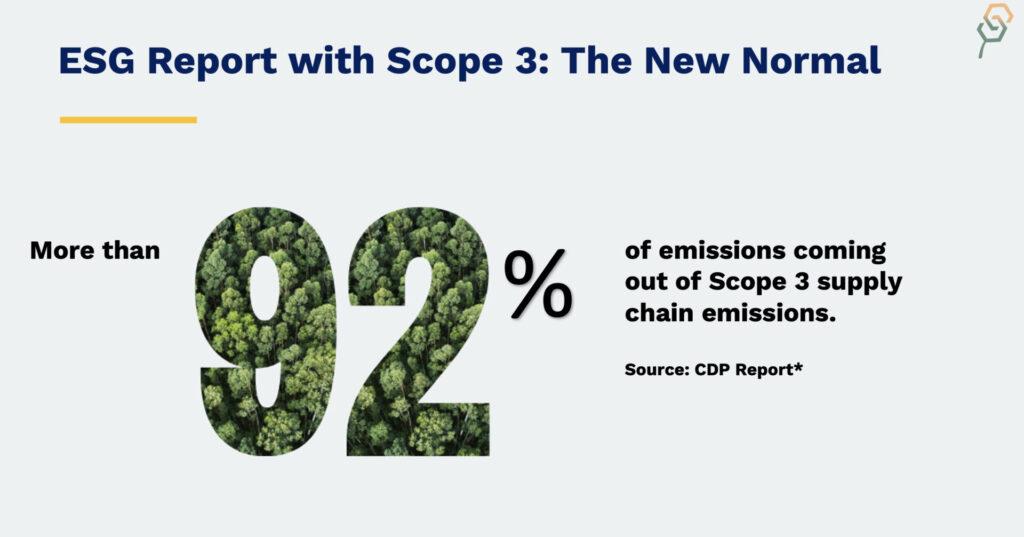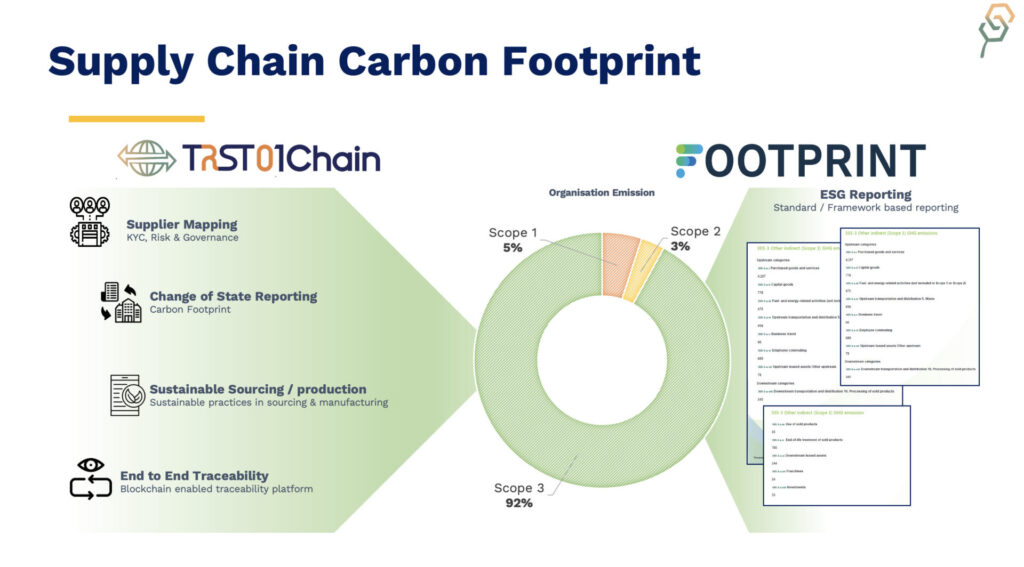Harnessing the Power of TRST01Chain for Comprehensive Scope 3 Reporting
12th Aug 2023

A significant portion of a company’s carbon emissions originates from its supply chain, often surpassing the direct emissions from its core operations. According to a study by the Carbon Disclosure Project (CDP), supply chain emissions are, on average, 11.4 times greater than a company’s direct emissions. This revelation emphasizes the need to focus on supply chain carbon footprints to combat climate change meaningfully.
Supply chain emissions have become a focal point for companies aiming to bolster their environmental credentials. With the increasing demand from stakeholders for corporate social responsibility, it’s more vital than ever for companies to address these emissions to maintain stakeholder trust and strengthen their market position.
Understanding the Supply Chain Carbon Footprint
The supply chain carbon footprint involves the total greenhouse gas (GHG) emissions produced at every product’s life cycle phase. This covers everything from raw material extraction to manufacturing, transportation, usage, and finally, disposal or recycling. The aim is to account for all direct and indirect carbon emissions associated with a product or service. These emissions, quantified using carbon dioxide equivalents (CO2e), allow us to compare various GHGs based on their global warming potential (GWP).
Benefits of Minimizing Supply Chain Carbon Emissions
Tackling the supply chain carbon footprint offers businesses a multitude of advantages:
- Cost Efficiency: Streamlining energy use, minimizing waste, and optimizing transportation results in reduced operational costs.
- Risk Management: By addressing environmental risks, companies can prevent potential issues such as regulatory fines or damaging publicity.
- Enhanced Brand Image: A proven commitment to sustainability can elevate a brand’s appeal to eco-conscious consumers.
- Competitive Edge: Being a frontrunner in addressing carbon footprint places companies a step ahead of their competitors, especially as regulations tighten and consumer demand for sustainable products grows.
- Investment Attraction: A strong performance in environmental, social, and governance (ESG) metrics often attracts investors, opening doors to additional capital.

TRST01’s Game-Changing Solutions for ESG Reporting and Management
The TRST01 Framework is an innovative solution that effectively addresses the challenges of managing supply chain carbon footprints. It achieves this by integrating with Web3 technology and the TRST01Chain. These frameworks provide advanced capabilities such as distributed ledger technology, smart contracts, and the Internet of Things. As a result, they enable greater transparency, traceability, and automation. By utilizing these cutting-edge technologies, businesses can significantly improve their supply chain management processes and reduce their carbon footprint.
- Transparent Data Collection and Analysis: The decentralized nature of the TRST01 Framework allows for tamper-proof and transparent data collection. This ensures all stakeholders have a clear understanding of their carbon emissions, enabling more informed decisions on reduction initiatives.
- Supplier Collaboration: The framework fosters cooperation between companies and suppliers. With predefined conditions for carbon reduction, trust and collaboration are enhanced, leading to more significant carbon savings.
- Sustainable Procurement: TRST01 aids businesses in implementing sustainable procurement by offering a verifiable record of environmental performance, ensuring decisions align with sustainability objectives.
- Enhanced Transportation Efficiency: Real-time data integration helps optimize transport logistics, thus reducing emissions.
- Transparent Carbon Offsetting: Emissions reductions and offsetting efforts can be securely recorded, proving a company’s dedication to sustainability.

The Power and Potential of TRST01Chain
The supply chain industry has been revolutionized by the integration of TRST01Chain, a powerful tool for businesses to achieve comprehensive ESG reporting. This innovative solution enables businesses to identify and address concerns at every stage of a product’s lifecycle, ensuring complete traceability. One of its most notable features is its ability to meticulously define the Scope 3 carbon footprint, providing businesses with detailed information to make informed decisions.
At the core of TRST01Chain’s operations is a strong emphasis on data. This focus ensures unparalleled transparency, compliance, and efficiency across the entire supply chain. TRST01Chain firmly believes that precise and trustworthy data is essential for businesses to thrive. By prioritizing data-driven operations, TRST01Chain is leading the way in helping businesses meet the demands of contemporary markets and stringent environmental regulations.
TRST01Chain’s solution comprises four pivotal tools: field mapping, compliance, data quality assurance, and blockchain-based immutability. These tools work together seamlessly to ensure that businesses can trace every aspect of their supply chain, ensuring optimal compliance and risk management. With TRST01Chain’s comprehensive approach, businesses can rest assured that they have access to precise, reliable data to make informed decisions.
Footprint by TRST01: A Revolutionary Approach to ESG Reporting
The innovative TRST01 Footprint model is a significant milestone in the realm of ESG reporting. This cutting-edge model utilizes the TRST01Chain to make a tangible difference in Scope 3 reporting by providing a comprehensive view of a company’s environmental impact. It is transparency, and insightful data help companies to understand their emissions and take meaningful steps toward reducing their carbon footprint.
Businesses must address the carbon footprint of their supply chain, especially given the urgency of combating climate change. By adopting innovative solutions such as the TRST01 Framework and TRST01Chain, companies can make a significant difference and contribute to a greener planet. This benefits the environment and ensures long-term profitability and sustainability in a constantly evolving marketplace.
Conclusion
In the evolving landscape of sustainability and corporate responsibility, the role of comprehensive and transparent reporting cannot be overstated. “FootPrint by TRST01: TRST01Chain for Scope 3 Reporting” showcases the groundbreaking potential of integrating modern technology into the ESG sector. By harnessing the power of TRST01Chain, businesses have a unique opportunity to enhance the integrity and accuracy of their supply chain carbon emissions reporting and to champion a more sustainable future. As we confront the mounting challenges of climate change and environmental degradation, tools like TRST01Chain emerge as beacons of innovation, fostering collaboration and driving actionable change. Embracing such transformative solutions will be pivotal for companies aiming to maintain a competitive edge while also honouring their commitments to the planet and its inhabitants.
write to us journey@trst01.com